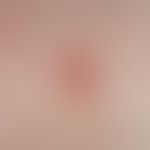Synonym(s)
DefinitionThis section has been translated automatically.
Epithelial cysts up to the size of a pinhead, filled with whitish horny beads (colloquially: skin gravel) without open connection to the skin surface. Milia are usually perceived as a cosmetic problem. Multiple milia can occur in the context of genodermatoses.
ClassificationThis section has been translated automatically.
-
Primary milia: develop spontaneously from interfollicular epidermis, vellus hair follicles or in excretory ducts of eccrine sweat glands.
- Milia of the infant
- Milia as partial manifestations of different syndromes. syndromes (see Gorlin-Goltz syndrome, Brooke-Spiegler syndrome, nevoid basal cell carcinoma syndrome, Bazex-Dupre-Crhistol syndrome, Rombo syndrome).
- Multiple eruptive milia : genodermatosis - autosomal dominant inheritance(?); acquired mainly as a side effect of therapy with tyrosine kinase inhibitors.
- Milia en plaque
-
Secondary milia: e.g. after bullous dermatoses or posttraumatic by displacement of keratinizing epithelial sections under the epidermis (e.g. after burns, abrasions, etc.).
- Secondary milia: in actinically damaged skin
- Pseudomilia: Clinically appearing as milia, whitish papules caused by deposition of oxalates in the skin (see oxalosis).
You might also be interested in
EtiopathogenesisThis section has been translated automatically.
- Primary milia: Develop spontaneously from interfollicular epidermis, vellus hair follicles or in excretory ducts of eccrine sweat glands (classical etiology in infants).
- Milia are also seen as partial manifestations of various genodermatoses. (see Gorlin-Goltz syndrome, ectodermal dysplasia, Brooke-Spiegeler syndrome, nevoid basal cell carcinoma syndrome, Bazex-Dupre-Crhistol syndrome, Rombo syndrome).
- Secondary milia: e.g. after bullous dermatoses or posttraumatic due to displacement of keratinizing epithelial sections under the epidermis (e.g. after burns, abrasions, etc.).
- Pseudomilia: Clinically appearing as milia, whitish papules caused by deposits of oxalates in the skin (see oxalosis below).
ManifestationThis section has been translated automatically.
- Occurs in young adults, especially in women.
- Milia are frequent, transient skin symptoms in newborns and infants during the 1st year of life (in about 50%) see below. Milia eruptive.
LocalizationThis section has been translated automatically.
Primary milia: V.a. on the face: lateral cheeks, periorbital, temples.
Secondary milia: often after bullous dermatoses or posttraumatic. Thus, the localization depends on the occurrence of the primary lesions.
Clinical featuresThis section has been translated automatically.
Multiple, disseminated, 0.1-0.4 cm large, spherical, yellowish-white, granular nodules, clearly demarcated from the surroundings, very superficially located in the skin. Post-lesional or post-traumatic milia often occur as small white, rough, grouped, symptomless (often accidental observation) nodules in the previously affected area.
HistologyThis section has been translated automatically.
Horn-filled, smallest epithelial cysts that are bound to a vellus hair follicle or to the acrosyringium.
Differential diagnosisThis section has been translated automatically.
Xanthelasma: Occurrence typically in the area of the eyelids. Usually clearly larger than 0.1-0.3 cm. Soft consistency!
Miliaria: Mostly acute onset after exposure to heat; usually pruritus, which is always absent in eruptive milia.
Hyperplasia of the sebaceous glands in infants: Typical localization is the bridge of the nose and cheeks (milia tend to be on the forehead, chin region possibly eyelid area).
Acne neonatorum: Typical picture of acne with closed and open comedones. Also inflammatory papules and pustules (signs of inflammation are always absent in milia!).
Colloid milium: Rare disease, glass pinhead-sized, transparent appearing, soft, grouped papules. In adult forms, occurrence in combination with other actinic changes.
TherapyThis section has been translated automatically.
Progression/forecastThis section has been translated automatically.
LiteratureThis section has been translated automatically.
- Dogra S et al (2002) Milia en plaque in a renal transplant patient: a rare presentation. Int J Dermatol 41: 897-898
- Dogra S, Kanwar A (2005) Milia en plaque. J Eur Acad Dermatol Venereol 19: 263-264
- Eckman JA et al (2002) Bullous systemic lupus erythematosus with milia and calcinosis. Cutis 70: 31-34
- Gallardo Avila PP et al (2021) Milia. In: StatPearls [Internet]. Treasure Island (FL): StatPearls Publishing; 2021 Jan-. PMID: 32809316
- Kalayciyan A et al. (2004) Milia in regressing plaques of mycosis fungoides: provoked by topical nitrogen mustard or not? Int J Dermatol 43: 953-956
- Kouba DJ et al (2003) Milia en plaque: a novel manifestation of chronic cutaneous lupus erythematosus. Br J Dermatol 149: 424-426
- Lee A et al (2002) Multiple milia due to radiotherapy. J Dermatolog Treat 13: 147-149
- Stefanidou MP et al (2002) Milia en plaque: a case report and review of the literature. Dermatol Surg 28: 291-295
- Thami GP et al (2002) Surgical Pearl: enucleation of milia with a disposable hypodermic needle. J Am Acad Dermatol 47: 602-603
Incoming links (21)
Contagious mollusc; Cyst; Epidermal cyst; Epidermolysis bullosa and congenital localized absence of the skin; Epidermolysis bullosa dystrophica dominans, generalized; Epidermolysis bullosa dystrophica recessive, severe generalized; Epidermolysis bullosa junctionalis generalized intermediaries (non-herlitz); Epidermolysis bullosa simplex generalized severe (dowling-meara); Erbium yag laser; Milia multiple eruptive; ... Show allOutgoing links (15)
Basal cell nevus syndrome; Bazex-dupré-christol syndrome; Brooke-spiegler syndrome; Colloidalmilium; Milia en plaque; Milia multiple eruptive; Milia of the infant; Miliaria; Neonatal cephalic pustulose; Oxalosis; ... Show allDisclaimer
Please ask your physician for a reliable diagnosis. This website is only meant as a reference.
















